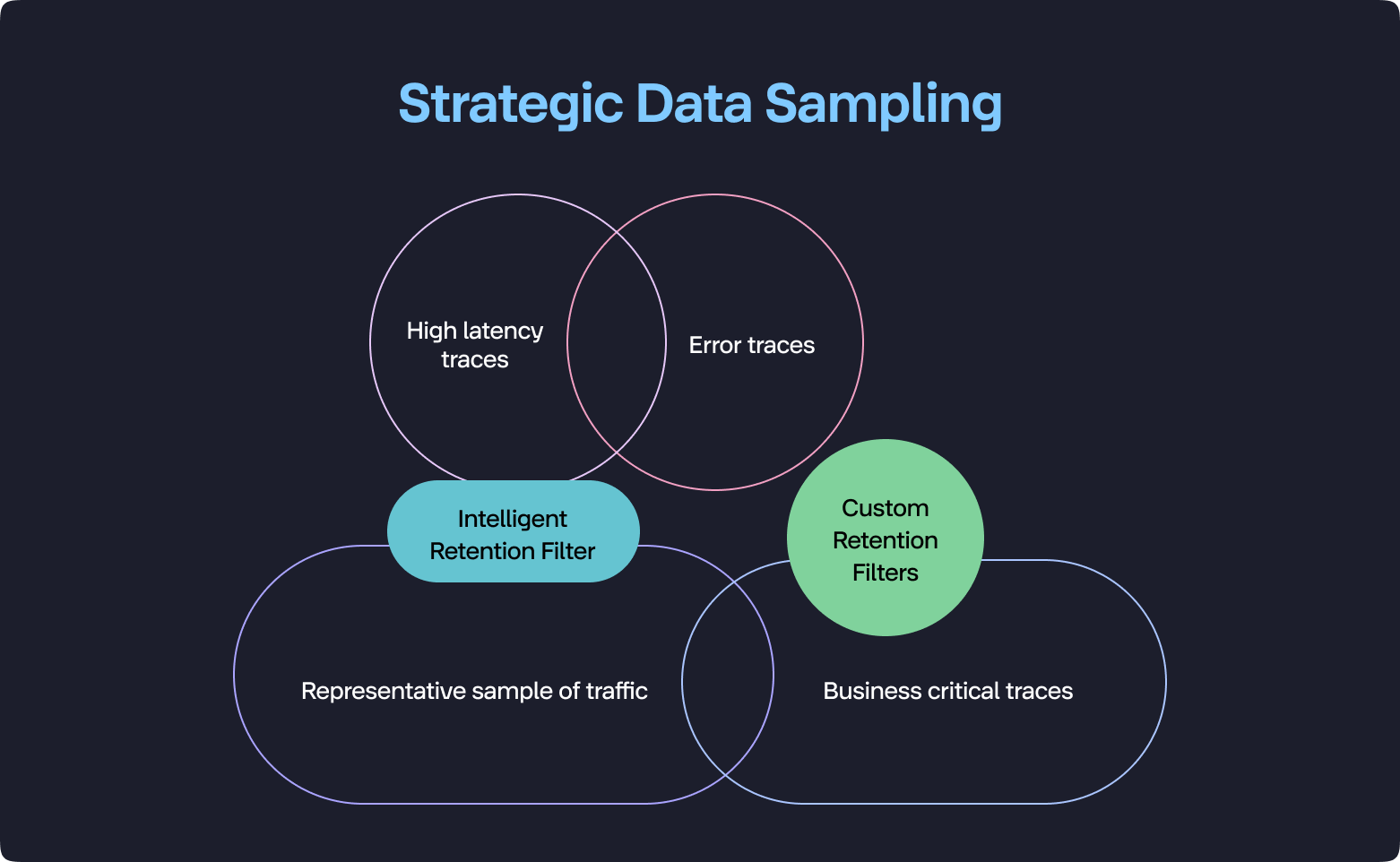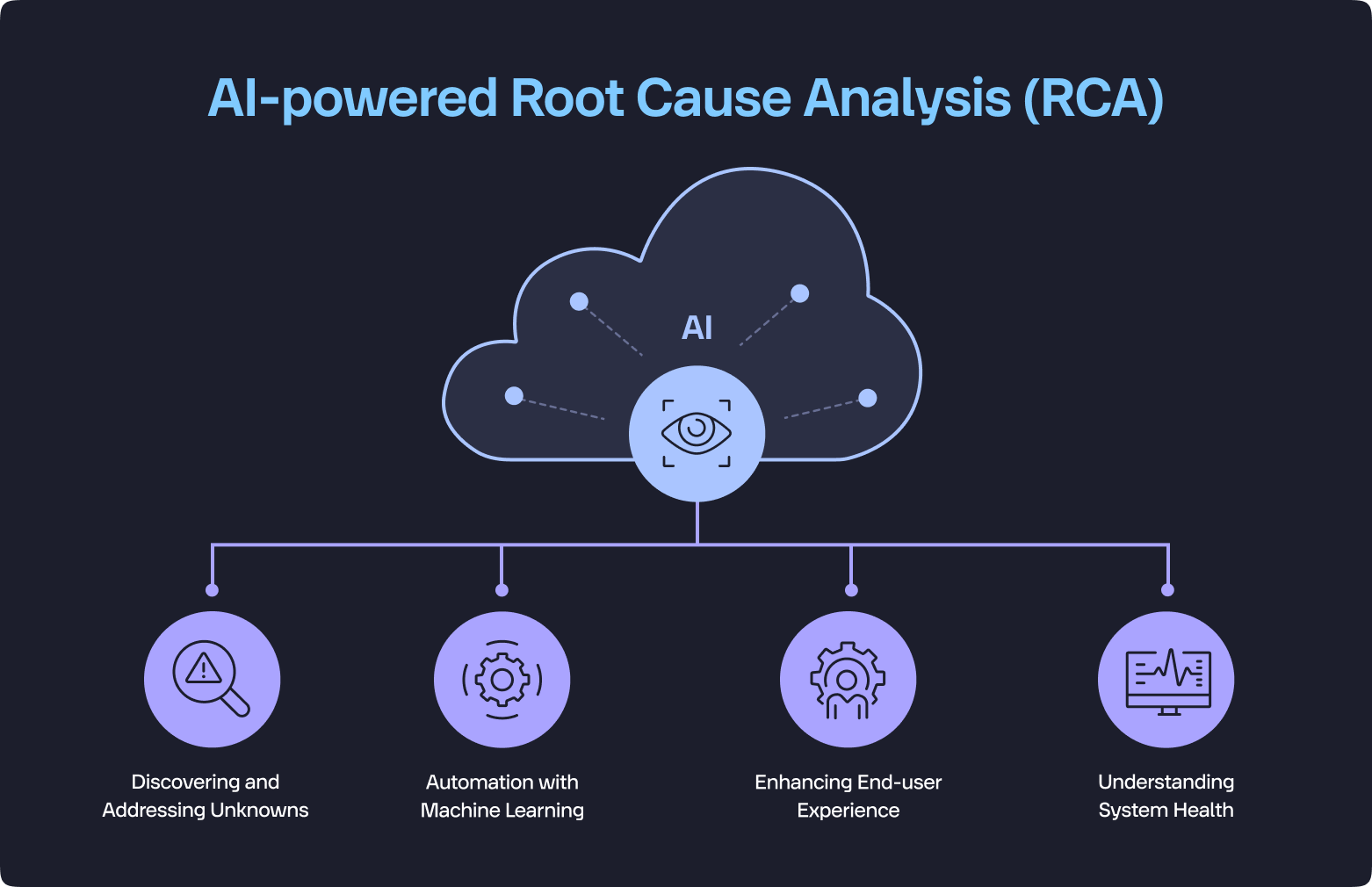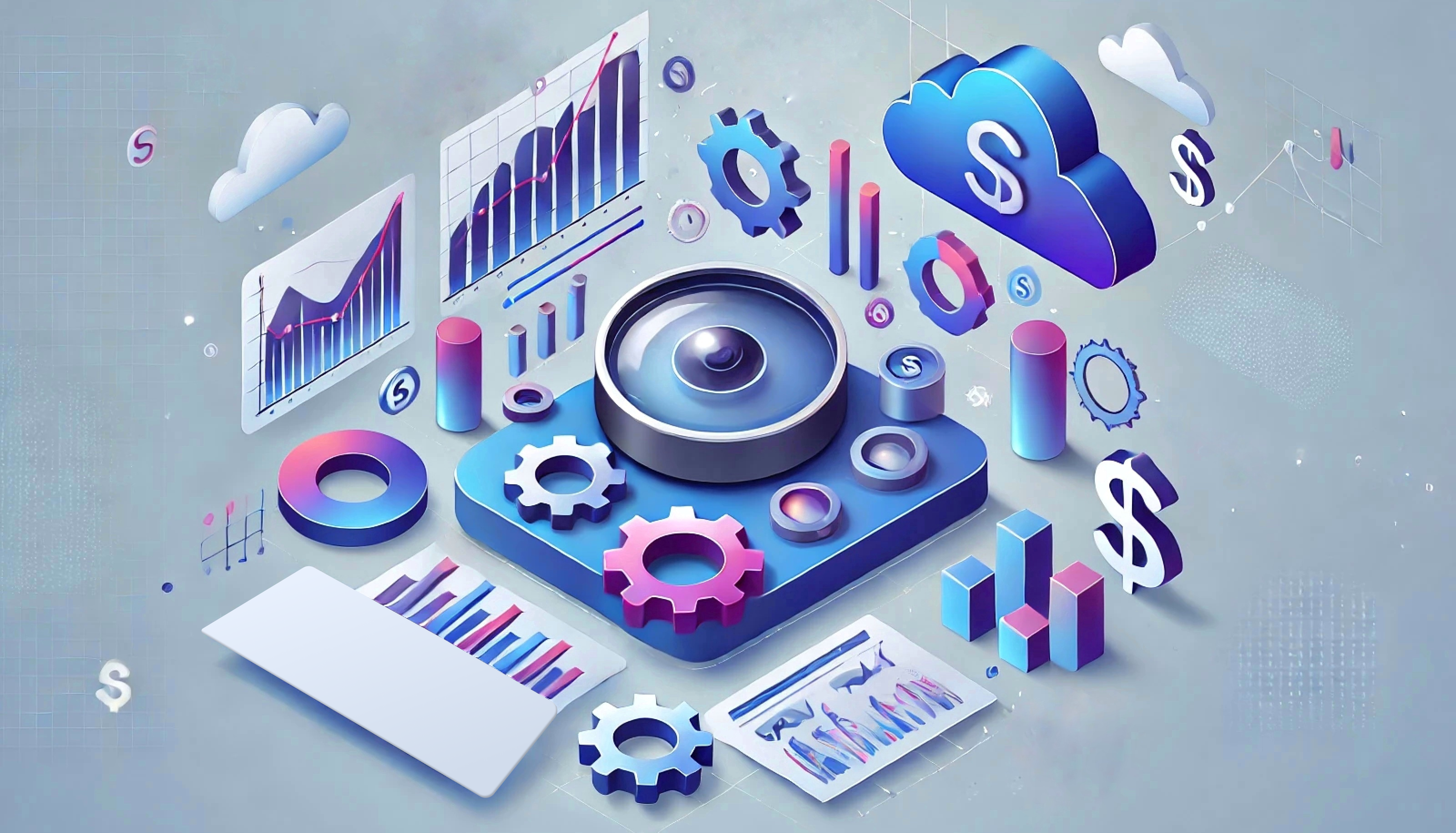In today's tech-driven world, we rely on software and hardware systems more than ever. By 2025, an estimated 100 zettabytes of data will be stored in the cloud, with data volumes growing at an average rate of 63% each month in companies. This massive increase in data presents significant challenges in managing, storing, and analyzing it. Observability tools help organizations proactively identify and resolve performance issues, optimize resource use, and ensure great user experiences. However, building a robust observability stack can sometimes lead to concerns about managing costs.
Finding a balance between achieving full visibility and keeping observability costs in check is crucial. This blog provides practical tips to help you optimize your observability setup without losing valuable insights.
10 Tips to Reduce Observability Costs While Maintaining Visibility
1. Centralize Your Monitoring Systems
Using multiple monitoring tools can lead to high licensing and maintenance costs. Consolidating your monitoring tools into a unified observability platform that integrates logs, metrics, and traces can streamline your monitoring processes and reduce overhead costs.
Steps to Centralize Monitoring:
- Evaluate Current Tools: Conduct an audit of all the monitoring tools currently in use.
- Identify Overlaps: Look for overlaps in functionality and data collected by different tools.
- Choose a Unified Platform: Select a comprehensive observability platform like KubeSense AI that can integrate logs, metrics, and traces.
- Check for AI Features and Roadmap: AI capabilities have become a critical factor in DevOps and development workflows. Leveraging AI can significantly enhance the ability to quickly identify and resolve issues, preventing potential negative impacts on customers. Exploring how AI can streamline these processes is now a key consideration in shaping future strategies and roadmaps. Therefore, it's essential to understand AI capabilities of product.
- Migrate Data: Plan and execute the migration of data and monitoring configurations to the new platform.
- Train Staff: Ensure your team receives proper training on the new platform to fully leverage its capabilities. However, select tools that seamlessly integrate into your existing workflows and are intuitive to use, without requiring additional skills or extensive learning.
Key Benefits:
- Cost Reduction: Reduces licensing and maintenance costs by eliminating redundant tools.
- Simplified Management: Streamlines monitoring processes, making it easier to manage and maintain.
- Improved Efficiency: Provides a centralized view of system health and performance, leading to faster issue detection and resolution.
- AI Observability: Enhanced efficiency can be a game-changer for DevOps teams and developers, significantly boosting overall organizational productivity.
KubeSense is a comprehensive observability platform offering a unified view of logs, metrics, traces, and events. It leverages AI-powered correlation to accelerate issue resolution. One of the most exciting features of KubeSense is its AI RCA, which intelligently identifies errors and provides AI-driven root cause analysis and recommendations to resolve issues.
2. Prioritize Essential Metrics
Tracking essential metrics that directly impact application performance and user experience is crucial for effective monitoring. Focusing on these critical metrics ensures that you capture the most relevant data without overwhelming your monitoring system.
Essential Metrics to Track:
- Server Response Times: Monitor the time it takes for servers to respond to requests.
- API Latencies: Track the response times of APIs to ensure they meet performance standards.
- Page Load Times: Measure how long it takes for web pages to load to maintain a good user experience.
- Resource Utilization: Monitor CPU, memory, and network usage across your infrastructure to identify potential bottlenecks.
- Error Rates: Track the occurrence of errors and exceptions within your applications to detect and address issues promptly.
Key Benefits:
- Focused Monitoring: Ensures that you are monitoring the most critical aspects of your system.
- Resource Optimization: Reduces the volume of data collected, leading to lower storage and processing costs.
- Improved Performance: Helps in identifying and resolving performance issues quickly, ensuring a better user experience.
- AI Capabilities: The benefit of using AI to simplify the process of identifying and resolving issues.
3. Select and Filter Key Data Sources
Filtering out unnecessary data at the source helps in reducing the volume of data ingested, thereby cutting down on storage and processing costs.
Using platforms like KubeSense to exclude irrelevant data and whitelist valuable sources can streamline your data collection process.
Steps to Filter Data:
- Identify Relevant Data Sources: Determine which data sources provide the most valuable insights for your monitoring needs.
- Set Up Filters: Configure filters to exclude irrelevant data, such as debug logs or information from non-critical services.
- Whitelist Key Sources: Whitelist specific data sources that are crucial for monitoring and analysis.
Key Benefits:
- Reduced Data Volume: Decreases the amount of data ingested, leading to lower storage and processing costs.
- Improved Data Quality: Ensures that only relevant and valuable data is collected, enhancing the quality of insights.
- Efficient Monitoring: Streamlines data collection processes, making monitoring more efficient and effective.
4. Implement Strategic Sampling
Using data sampling techniques to capture significant subsets of data can reduce storage and processing costs while still providing valuable insights. Strategic sampling allows you to collect enough data to identify trends and anomalies without the overhead of processing every single data point.
KubeSense AI offers multiple smart options for sampling and even provides an effective deployment solution for completely avoiding sampling if that is a concern.
Steps for Strategic Sampling:
- Define Sampling Rate: Determine an appropriate sampling rate that captures sufficient data for analysis without overwhelming the system.
- Select Key Metrics: Identify which metrics should be sampled to ensure critical data is still collected.
- Implement Sampling: Configure your observability platform to apply the defined sampling rate to the selected metrics.
Key Benefits:
- Cost Savings: Reduces storage and processing requirements, leading to lower costs.
- Efficient Data Management: Manages large volumes of data more effectively by focusing on key subsets.
- Maintained Visibility: Ensures that critical trends and anomalies are still detected and analyzed.

Transforming raw data into a more compact format before ingestion can reduce storage volume and make the data more manageable. Tools like Logstash can parse logs, extract relevant fields, and remove unnecessary information, making the data more cost-effective to store.
Steps to Utilize Data Transformation:
- Define Transformation Rules: Identify the data fields that are essential and those that can be excluded.
- Configure Tools: Use tools like Logstash to set up data transformation rules that compact the data before ingestion.
- Monitor Transformation: Continuously monitor the transformation process to ensure data quality is maintained.
Key Benefits:
- Reduced Storage Volume: Lowers the amount of storage needed by eliminating unnecessary data.
- Improved Data Efficiency: Makes the data more compact and manageable, enhancing processing efficiency.
- Cost Savings: Decreases storage costs by reducing the volume of data stored.
KubeSense features a comprehensive log transformation layer that allows users to perform various transformations, such as extraction, replacement, blocking, and removal.
6. Use Data Compression Methods
Compressing data before storage can significantly reduce storage requirements and costs. Data compression techniques help in minimizing the physical storage space needed, leading to lower storage costs.
Steps for Data Compression:
- Choose Compression Methods: Select appropriate compression methods that balance compression ratio and processing overhead.
- Configure Compression: Set up your observability platform to apply the chosen compression techniques before storing data.
- Monitor Performance: Regularly monitor the performance impact of data compression to ensure it does not affect system performance.
Key Benefits:
- Reduced Storage Costs: Minimizes the physical storage space needed, leading to lower costs.
- Efficient Data Management: Makes data storage more efficient by compressing data before it is stored.
- Maintained Data Quality: Ensures that data quality is preserved during the compression process.
Unlike traditional compression techniques, KubeSense utilizes data-type-specific compression methods. Our AI-driven compression decision engine determines the most effective compression technique for each data type, which can vary significantly based on the nature of the data. This approach has allowed KubeSense to achieve compression rates exceeding 90% for several customers, resulting in substantial cost savings.
7. Streamline Data Retention Policies
Data retention policies are crucial for managing observability costs. Logs and traces provide a historical record of system activity but can be expensive to store long-term. Implementing intelligent data retention policies can help in reducing storage costs without losing valuable insights.
Steps to Streamline Data Retention:
- Determine Retention Needs: Define clear retention periods for different data types based on their importance and usage frequency.
- Adopt Tiered Storage Solutions: Store frequently accessed data in high-performance tiers and archive less accessed data in cost-effective storage.
- Implement Data Lifecycle Management (DLM): Automate data archiving and deletion based on retention policies to ensure compliance and optimize storage costs.
Key Benefits:
- Cost Savings: Reduces long-term storage costs by managing data retention efficiently.
- Optimized Storage: Ensures that high-performance storage is reserved for critical data, improving overall storage efficiency.
- Compliance: Maintains compliance with data retention policies and regulations.
KubeSense offers flexible data retention management policies, allowing retention periods to be customized based on various needs, including regulatory requirements, regional specifications, customer preferences, or service-specific needs. These settings can be easily configured through the intuitive UI in the Admin settings. Additionally, KubeSense provides a multi-tier storage option, enabling seamless data movement between SSD, HDD, S3, and other storage types. This flexibility ensures optimal cost savings while maintaining the ability to query data across different storage tiers without any hassle.
8. Optimize with Dynamic Observability
Traditional observability collects data at a constant rate, regardless of system activity, which can be inefficient and costly. Dynamic observability allows you to adjust data collection in real-time based on system behavior, optimizing resource use.
Steps for Dynamic Observability:
- Scale Data Monitoring as Required: Adjust data collection rates in real-time based on current system activity levels.
- Highlight Anomaly Detection: Use AI-powered tools to detect deviations from normal behavior and focus data collection on resolving issues.
- Utilize Temporary Trace Data: Use ephemeral tracing techniques for short-term analysis, eliminating the need for long-term storage.
Key Benefits:
- Resource Optimization: Dynamically adjusts resource use based on system activity, leading to cost savings.
- Targeted Monitoring: Focuses data collection on critical areas, improving monitoring efficiency.
- Cost Efficiency: Reduces unnecessary data collection and storage, lowering overall costs.
With KubeSense, you have the freedom and flexibility to choose what to observe, when to observe it, and how much data to monitor. Our AI recommendations offer automated options based on activity levels, error rates, and other key performance metrics, ensuring optimal observability tailored to your needs.
9. Automate Anomaly Detection and Root Cause Analysis
Manual monitoring and troubleshooting are resource-intensive and time-consuming. Automating anomaly detection and root cause analysis using AI and machine learning algorithms can quickly identify and resolve issues, reducing the need for constant human oversight.
Steps for Automation:
- Implement AI and Machine Learning: Use AI and machine learning algorithms to automate the detection of anomalies and root causes.
- Automate Detection and Analysis: Configure automated systems to quickly identify and resolve issues without human intervention.
- Monitor Automation: Regularly review the performance of automated systems to ensure they are functioning effectively.
Key Benefits:
- Reduced Labor Costs: Lowers the need for constant human oversight, reducing labor costs.
- Improved Response Time: Quickly addresses anomalies and root causes, minimizing downtime.
- Enhanced System Reliability: Maintains robust system performance through continuous monitoring and automated issue resolution.
KubeSense's most popular feature is its AI RCA (Root Cause Analysis). This feature examines all relevant telemetry data, including logs, metrics, traces, and events, to identify issues. It then determines the root cause and offers AI-recommended solutions for resolving the problem.
Maintaining data and real-time monitoring across multiple tools can lead to observability tool sprawl, increasing complexity and costs. Simplifying tool management by unifying observability tools onto a single platform can streamline data management and reduce costs.
Steps to Simplify Tool Management:
- Unify Observability Tools: Consolidate data sets onto a unified platform to eliminate redundancy.
- Use One Platform for All Tools: Reduce administrative overhead by managing fewer tools on a single platform.
- Carry Out the Consolidation: Start consolidating tools by purchasing new software or simplifying internal processes.
Key Benefits:
- Cost Reduction: Reduces licensing and maintenance costs by eliminating redundant tools.
- Simplified Management: Streamlines data management and reduces the complexity of monitoring.
- Improved Efficiency: Provides a centralized view of system health and performance, leading to faster issue detection and resolution.
KubeSense: Your Cost-Effective and AI-Powered Observability Solution
KubeSense is a comprehensive cloud observability platform that provides real-time monitoring of cloud infrastructure. It integrates metrics, logs, traces, and events into a unified timeline, offering complete visibility across multiple environments at a cost-effective price. With autonomous monitoring capabilities, KubeSense can detect issues and errors, and it features AI-powered Root Cause Analysis (RCA) that provides accurate AI recommendations for resolving problems.

Conclusion
Reducing observability costs without sacrificing visibility is achievable. By optimizing data ingestion, implementing smart data retention policies, embracing dynamic observability, consolidating tooling, and choosing the right observability platform, organizations can maintain robust system monitoring while keeping costs in check.
KubeSense provides a comprehensive and cost-effective solution for modern observability requirements. With the powerful integration of AI and large language models (LLMs), KubeSense excels in issue identification, root cause analysis, and offering AI-driven solution recommendations. This platform not only helps in achieving significant cost savings but also enhances the reliability and performance of your IT systems.
Schedule a free demo today to learn more about how KubeSense can help you optimize your observability setup.


 Blog
Blog



